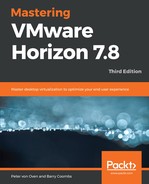File servers are often overlooked when it comes to creating a Horizon View environment, but often play a critical role in the overall functionality of the VDI environment.
For example, they will be storing things like ThinApp packages, user profiles, or application layers from App Volumes. First, size your file server for performance, ensure that your file server has enough RAM and CPU to meet user demands, particularly at peak times, and then continue to monitor utilization, and ensure that you add extra capacity as and when it is required.
It's not just about CPU and memory performance—the hard disk performance associated with your file server will also be critical.
With your applications and personas being saved on the file servers, we need to consider the effect of these resources being unavailable when the users are trying to use their desktops. In the case of the layered applications, App Volumes app layers may not attach or might fail midway through the user using an application if the file server goes offline. With the end user's persona stored on a file server, this could have a severe impact on the users accessing their data, or there may be unconsidered effects, such as the application data being unable to load or reduced performance of the desktop.
As such, the availability of file servers needs to be a serious consideration if you plan on using a shared storage device that supports CIFS shares. You could consider storing these files on this device; otherwise, a clustered file server or a DFS share should probably be considered to ensure availability. Of course, these decisions need to be taken alongside the business needs. If your View environment is going to be small initially, and your file server is stored on a virtual environment, the built-in HA functionality might be enough for your requirements.
